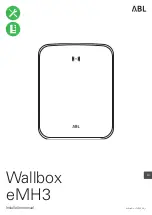Configuration Guide for
LM3647 Reference Design
The LM3647 provides a single-chip charge management
solution for Nickel Cadmium, Nickel Metal Hydride and
Lithium-Ion cells. The device handles the entire charging
process from rejuvenating deeply discharged cells to provid-
ing a number of charge termination and maintenance op-
tions. The LM3647 Demo Board allows users to create a
battery charging solution with little effort.
Standard Cells
The charge and discharge parameters of cells are often
identical within families of size and capacity when normal-
ized to a standard cell rating. The standard cell rating (C) is
defined as the capacity of a new cell under constant-current
discharge at room temperature. Since discharge and charge
are inversely related, the standard cell rating is also used in
reference to charge rates. Therefore, a charge rate of 0.1C
means that a completely discharged cell, at perfect charge
efficiency, will attain full charge in 10 hours.
Jumper Locations and Pin Numbering
Jumpers on the LM3647 Reference Design are shown in
Figure 1. The dots indicate the position of pin 1.
Nickel-Cadmium Battery Configuration
Ni-Cd cells have a nominal voltage of 1.2V and can reach a
peak of 1.85V during charging. The rated cell capacities of
Ni-Cd cells are based on minimum values. When cells are
partially discharged and repeatedly charged, they become
prone to an effect known as
″
memory
″
. To improve Ni-Cd
battery service life, the Discharge Before Charge feature
(which also enables Maintenance mode) should be enabled.
TABLE 1. Ni-Cd Jumper Settings
Battery
Chemistry
Type
Number
of
Cells
Voltage Range
PWM
Feedback
Current
Control
Battery
Type
Discharge
Maintenance
J11
J12
J14
J6
J5
J2
Ni-Cd
4
13–14
13–14
5–6
Table 3
GND
Table 5
Ni-Cd
5
3–4
3–4
7–8
Table 3
GND
Table 5
Ni-Cd
6
9–10
9–10
7–8
Table 3
GND
Table 5
Ni-Cd
8
11–12
11–12
9–10
Table 3
GND
Table 5
Ni-Cd
10
7–8
7–8
9–10
Table 3
GND
Table 5
Nickel-Metal Hydride Configuration
Ni-MH cells also have a nominal voltage of 1.2V and can
reach a peak of 1.85V during charging. The rated cell ca-
pacities of Ni-MH cells are based on average values. For
Ni-MH cells, the rated capacity is determined at a discharge
rate that fully depletes the cell in five hours. The Ni-MH cell
provides 30% greater capacity over a standard Ni-Cd and is
less affected by memory than the Ni-Cd cell. The Discharge
Before Charge feature is not as important for Ni-MH, but can
still be helpful in extending battery life.
TABLE 2. Ni-MH Jumper Settings
Battery
Chemistry
Type
Number
of
Cells
Voltage Range
PWM
Feedback
Current
Control
Battery
Type
Discharge
Maintenance
J11
J12
J14
J6
J5
J2
Ni-MH
4
13–14
13–14
5–6
Table 3
V
CC
Table 5
Ni-MH
5
3–4
3–4
7–8
Table 3
V
CC
Table 5
Ni-MH
6
9–10
9–10
7–8
Table 3
V
CC
Table 5
Ni-MH
8
11–12
11–12
9–10
Table 3
V
CC
Table 5
Ni-MH
10
7–8
7–8
9–10
Table 3
V
CC
Table 5
AN101316-1
FIGURE 1. Jumper Location
National Semiconductor
Application Note 1165
Noel Baisa
September 2000
Configuration
Guide
for
LM3647
Reference
Design
AN-1
165
© 2000 National Semiconductor Corporation
AN101316
www.national.com


















